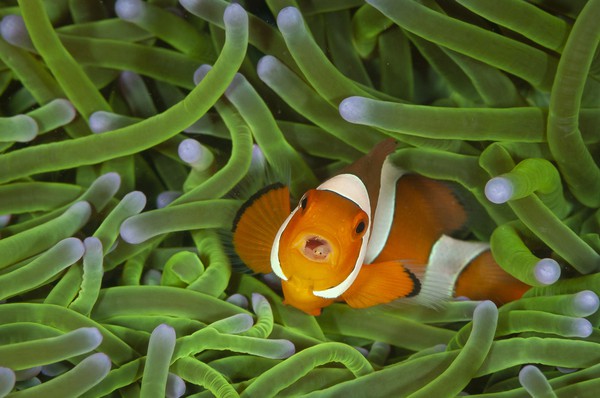The Wildlife Photographer of the Year has been founded in 1965 to showcase the best nature photography. This year saw more than 49,000 entries from around the world despite the coronavirus pandemic.
Here are the winners’ stunning photos and their captions.

1. The Embrace (Grand Title Winner and Animals in their Environment Winner) A tigress hugs and ancient Manchurian fir, rubbing her cheek against the bark to leave secretions from her scent glands. She is an Amur, or Siberian tiger in Russia’s Land of the Leopard National Park. Hunted almost to extinction in the past century, the population is still threatened by poaching and logging, which also impact their prey – mostly deer and wild boar.

2. A Tale of Two Wasps (Behavior Winner) This remarkable simultaneous framing of a red-banded sand wasp (left) and a cuckoo wasp about to enter next-door nest holes is the result of painstaking preparation. The female cuckoo wasp – just six millimeters long – parasitizes the nests of certain solitary digger wasps, laying her eggs in her hosts’ burrows so that her larvae can feast on their eggs or larvae. The much larger red-banded sand wasp lays her eggs in her own burrow, which she provisions with caterpillars, one for each of her young to eat when they emerge. Frank Deschandol’s original aim was to photograph the vibrant cuckoo wasp. In a sandy bank on a brownfield site near his home in Normandy, France, he located a tiny digger wasp burrows suitable for a cuckoo wasp to use. He then set up an infrared beam that, when broken by a wasp, would trigger the super-fast shutter system he had built. Despite the extremely narrow depth of field and tiny subject, he captured not only the cuckoo wasp but also the sand wasp.

3. A Fox for All Seasons (Animal Portraits Highly Commended) As it hunts along the snow-covered valley, an American red fox is hit side on by a gust of wind, parting its thick winter coat to reveal the fine fur underlayer. Undeterred, it kept listening intently for any sound of a vole or mouse scurrying beneath the snow. It would then tilt its head from side to side and pounce through. On a freezing February afternoon in Yellowstone National Park in Wyoming, John Blumenkamp watched the fox for hours, weathering the wind and sudden drops in temperature to take this stark image of a winter survivor.

4. A Mean Mouthful (11-14 Years Old Winner) On a diving holiday in North Sulawesi, Indonesia, Sam Sloss stopped to watch the behavior of a group of clownfish as they swam with hectic and repeated patterns in and out and around their home, a magnificent anemone. He was intrigued by the expression of one fish, its mouth being constantly open, holding something. Rather than following the moving fish in his viewfinder, Sloss positioned himself where he knew it would come back into the frame. It was only when he downloaded the photos that he saw tiny eyes peeping out of its mouth. It was a “tongue-eating louse,” a parasitic isopod that swims in through the gills as a male, changes sex, grows legs, and attached itself to the base of the tongue, sucking blood.

5. Watching You Watching Them (Urban Wildlife Winner) What a treat for a biologist – the species you want to study chooses the nest right outside your window. The Cordilleran flycatcher is declining across western North America as the changing climate causes shrinkage of the riparian habitats (i.e. river and other freshwater corridors) along its migratory routes and on its wintering grounds in Mexico. In Montana’s Rocky Mountain Front, it typically nests in crevices and on canyon shelves. But one pair picked this remote research cabin instead, perhaps to avoid predation. The nest was built on the head of a window frame by the female. Both parents were feeding the nestlings, flying out to snatch insects in mid-air or hovering to pick them off leaves. So as not to disturb the birds or attract predators to the nest, Alex Badyaev hid his camera behind a large piece of bark on an ancient spruce tree leaning against the cabin. He directed a flash toward the trunk, so the scene would be illuminated by reflection, and operated the setup remotely from the cabin. He captured his shot as the female paused to check on her four nestlings. At 12 days old, they will probably fledge in a few days. Behind her – the cabin serving as a conveniently spacious hide – the biologist recorded his observations.
You can view more of the winners in the museum’s website.
You might want to read:
– 7 of the best animal images of the decade from British Wildlife Photography Awards
– This year’s finalists of the 2020 Comedy Wildlife Photography Awards might be the funniest photos you’ll see
– Photo of mice fighting wins Wildlife Photography Awards



